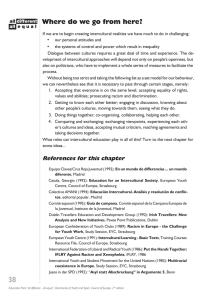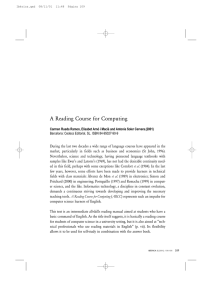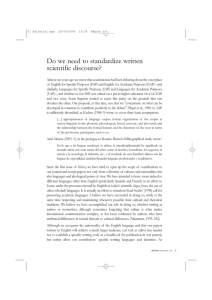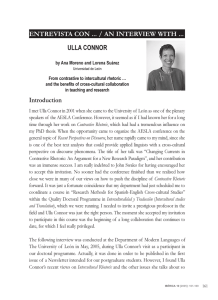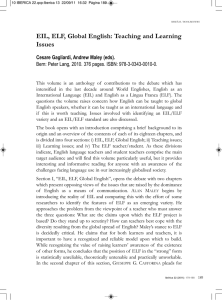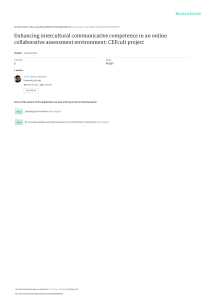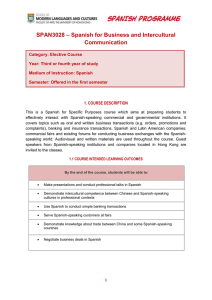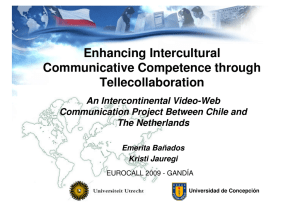berica 13
Anuncio
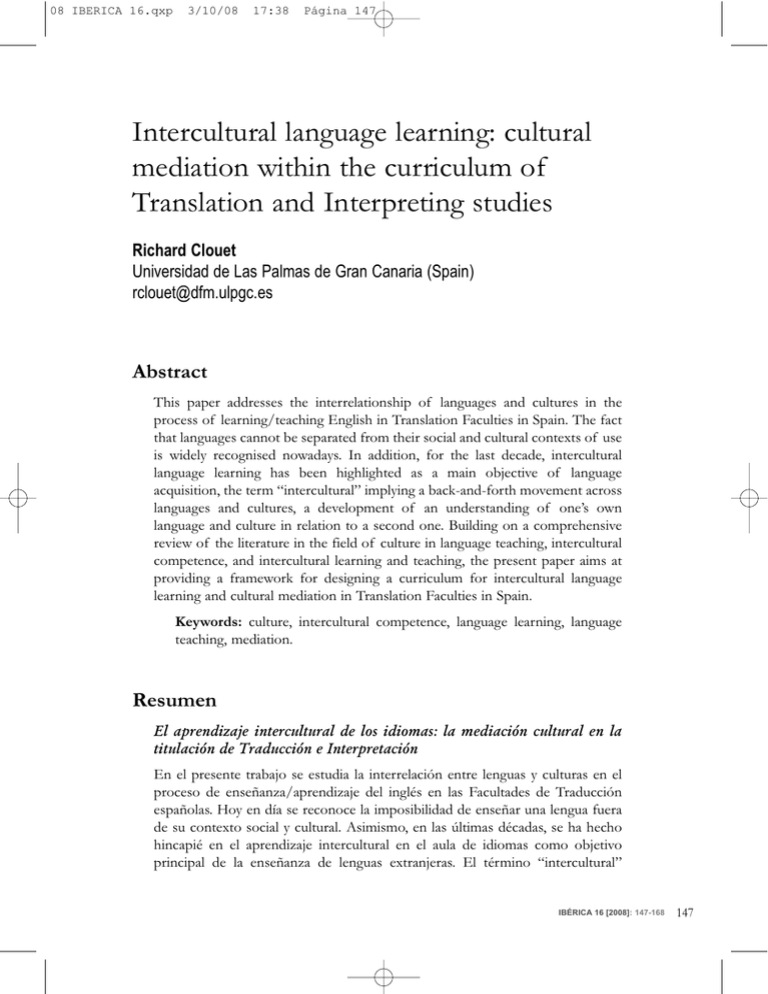
08 IBERICA 16.qxp 3/10/08 17:38 Página 147 Intercultural language learning: cultural mediation within the curriculum of Translation and Interpreting studies Richard Clouet Universidad de Las Palmas de Gran Canaria (Spain) [email protected] Abstract This paper addresses the interrelationship of languages and cultures in the process of learning/teaching English in Translation Faculties in Spain. The fact that languages cannot be separated from their social and cultural contexts of use is widely recognised nowadays. In addition, for the last decade, intercultural language learning has been highlighted as a main objective of language acquisition, the term “intercultural” implying a back-and-forth movement across languages and cultures, a development of an understanding of one’s own language and culture in relation to a second one. Building on a comprehensive review of the literature in the field of culture in language teaching, intercultural competence, and intercultural learning and teaching, the present paper aims at providing a framework for designing a curriculum for intercultural language learning and cultural mediation in Translation Faculties in Spain. Keywords: culture, intercultural competence, language learning, language teaching, mediation. Resumen El aprendizaje intercultural de los idiomas: la mediacin cultural en la titulacin de Traduccin e Interpretacin En el presente trabajo se estudia la interrelación entre lenguas y culturas en el proceso de enseñanza/aprendizaje del inglés en las Facultades de Traducción españolas. Hoy en día se reconoce la imposibilidad de enseñar una lengua fuera de su contexto social y cultural. Asimismo, en las últimas décadas, se ha hecho hincapié en el aprendizaje intercultural en el aula de idiomas como objetivo principal de la enseñanza de lenguas extranjeras. El término “intercultural” IBÉRICA 16 [2008]: 147-168 147 08 IBERICA 16.qxp 3/10/08 17:38 Página 148 RICHARD CLOUET implica un movimiento de vaivén entre lenguas y culturas, el desarrollo de la comprensión de la lengua y cultura propias en relación con otra lengua y cultura. En este análisis partiremos de un repaso amplio de la investigación acerca del papel de la cultura dentro de la enseñanza de idiomas, de la competencia intercultural y de la enseñanza/aprendizaje intercultural, para posteriormente elaborar una propuesta didáctica que integre un aprendizaje intercultural en las Facultades de Traducción en España, insistiendo particularmente en la noción de mediación cultural. Palabras clave: cultura, competencia intercultural, aprendizaje de lenguas, enseñanza de lenguas, mediación. Introduction The task of both translators and interpreters is to achieve successful communication, and particularly successful intercultural communication. The latter involves much more than verbal communication and includes non-verbal communication –devices, such as body language, the use of space and time, etc., which differ from culture to culture. Intercultural communication, indeed, is a complex competence that goes beyond the visible aspects of culture and embraces the so-called invisible aspects, namely those which govern behaviour based on the beliefs and values of a given social group. As such, intercultural communication competence is an area of study that is becoming more relevant in the increasingly multicultural communities that we live in –notably in teaching/learning environments– and much progress has been made in this area of research since the publication of Edward T. Hall’s The Silent Language, in 1959.1 Therefore, it is the translator and interpreter’s role to reformulate a message, to communicate ideas and information from one cultural context to another without altering what is expressed in the original text or speech through the language of the writer or speaker. This is the main reason why translators and interpreters actually mediate rather than merely translate, as their task is to facilitate the process of intercultural communication. This aspect of translation should be taken more seriously into account in our Translation and Interpreting Faculties, notably in the language class, where we think that teaching/learning should be undertaken with that perspective in mind. This paper departs from a brief theoretical review of the traditional approaches to culture in the language class, and then proceeds to explaining what we understand by intercultural language learning. Finally, it provides 148 IBÉRICA 16 [2008]: 147-168 08 IBERICA 16.qxp 3/10/08 17:38 Página 149 INTERCULTURAL LANGUAGE LEARNING particular examples of tasks that can be carried out in the language class for students of translation and interpreting studies. Approaches to culture in language teaching Although research on cultural aspects in language teaching started almost half a century ago, it was only in the 1980s that a greater number of books and articles became entirely devoted to this field. When reviewing the literature, it is possible to identify three major approaches to teaching culture in the language class: (1) teaching history, geography and the fine arts, including literature; (2) teaching students to observe the norms in the foreign culture that allow humans to live in peace and harmony with each other and their environment; (3) teaching students to interact in the new language and culture. These three approaches represent different views of the nature of culture, different levels of concern for the relationship between language and culture, and finally different understandings of the place of culture in language education. “Big C culture” would be the first approach. This is the most traditional approach to teaching culture as a part of modern language teaching: mainly culture through literature, but also through the history, geography, and institutions of the target language country. In this case, cultural competence is viewed as a body of knowledge about those different aspects and it is measured in terms of the breadth of reading. “Big C culture”, also sometimes called “high culture”, is seen as background information to understand language and society. In this approach, the learner does not use the language to communicate, but only to observe the culture s/he is studying. Language is primarily used for naming events, institutions, people, and places, and for reading texts. Kramsch (1995) argues that much of this approach to teaching started with the teaching of classical languages through which educated people had access to universal culture. The second approach that could be mentioned is that of viewing culture as a set of societal norms. Anthropologists such as Gumperz (1982a & 1982b) and Hymes (1972 & 1974) can be said to be at the root of this cultural approach which became prevalent in the 1980s. Cultures are then started to be described in terms of the practices and values which typify them. In turn, cultural competence means knowing about what people from a given cultural group are likely to do, as well as understanding the cultural values placed IBÉRICA 16 [2008]: 147-168 149 08 IBERICA 16.qxp 3/10/08 17:38 Página 150 RICHARD CLOUET upon certain ways of acting or upon certain beliefs. The main problem concerning this approach is that the learner remains primarily an observer and interpreter of what happens in the target culture with his own cultural preconceptions and even prejudices, which can lead to the danger of stereotyping the target culture (Crawford-Lange & Lange, 1984), especially in contexts where the possibilities for interactions between speakers are limited. The third approach sees culture as sets of practices. In other words, learners are sensitized to a wide range of contexts in which they are required to act. Cultural competence is, at this point, regarded as the ability to interact in the target culture in informed ways, the objective for the learner being to develop an intercultural perspective in which comparison between the native and the target cultures and languages will help him/her to develop intercultural communicative skills. Although we believe that these approaches to culture do not represent alternatives and should all contribute to different understandings of the target culture, thus providing a solid basis of knowledge for the learner, we have chosen the last approach as the focus for the present paper. This last approach is, indeed, the only one that does not limit the perspectives to mere factual information (Nostrand, 1974; Brooks, 1975; Lafayette, 1978) and that is not described as a static view of culture (Liddicoat, 2002). Contrarily, this view can be defined as a dynamic approach to culture (Liddicoat, 2002): learners are required to interact, to structure and understand their own social world in order to be able to communicate with people from other cultures. As such, culture is not about background information, but about acting, interpreting and understanding (Kramsch, 1993a; Liddicoat, 1997). Namely, cultural knowledge is not a case of acquiring information about the foreign culture; it is about being capable of interpreting cultural contexts and actually interacting and performing in those contexts. It is precisely this dynamic view of culture that translation students need to understand and acquire. What Kramsch (1993b) applies to all language users is obviously applicable to translators. Indeed, the latter, as linguistic and cultural mediators, need to be able to negotiate meaning across cultural boundaries, establishing their role and identity as users of other languages. They must understand how language is used and how things are said and done in a determined cultural context. All of the above imply that languages and, in this case, languages for translation students, cannot be taught independently from the context in 150 IBÉRICA 16 [2008]: 147-168 08 IBERICA 16.qxp 3/10/08 17:38 Página 151 INTERCULTURAL LANGUAGE LEARNING which they are used (Kramsch, 1993a; Byram, 1988). A language will always be affected by the context in which it is found and understood by people who CORRESPONDIENTE share the same understanding of that context. Getting to know each 1 CORRESPONDIENTE AL ARCHIVO 08 IBERICA FIGURA 1FIGURA AL ARCHIVO 08 IBERICA 16.PDF 16.PDF other is thus not enough; understanding each other is much more important as it will be the only way of achieving intercultural communication. Culture Culture world (the cultural world knowledge (theknowledge cultural knowledge weknowledge we culture in context have the world works) have about how the about world how works) (what is considered spoken/writtenspoken/written genres (what isgenres considered elegant, or logical in one good, elegant,good, or logical in one language/cultural context language/cultural context may not be may not be thought in the same way in another thought of in the same of way in another language/cultural context) language/cultural context) culture in context culture in culture in general text general text structure structure pragmatic (normsuse, of language use, culture within culture within pragmatic norms (norms norms of language utterances utterances especially politeness) especially politeness) norms(what of interaction (what it is appropriate culture in the culture in the norms of interaction it is appropriate to say point at a particular point in a conversation, organisation organisation to say at a particular in a conversation, and what someone expected to say at and selection and selection and what someone is expected to is say at this point) of units of this point) of units of language language Language grammar/ lexicon/ prosody/ pronunciation/ grammar/ lexicon/ prosody/ pronunciation/ culture in culture in kinesics (the ways in which we encode kinesics (the ways in which we encode linguistic and linguistic and ideas, concepts, and ideas, concepts, and relationships inrelationships in Language language, including language, things like appropriate paralinguistic paralinguistic thingsincluding like appropriate structures registers, appropriate amounts of physical structures registers, appropriate amounts of physical contact, appropriate personal contact, appropriate personal space, etc.) space, etc.) Figure 1.between Relationship between language and culture Crozet1999). & Liddicoat, 1999). Figure 1. Relationship language and culture (adapted from (adapted Crozet & from Liddicoat, Approaches like Buttjes and Byram’s (1991), Nostrand’s (1991) or Liddicoat’s (2002) have shown the need to recapture a definition of language competence for second language teaching and learning which would restore a fuller understanding of what is meant by “communicative competence” (Hymes, 1972; Saville-Troike, 1989). Crozet and Liddicoat’s (1999) explanation of the different levels of interaction between language and culture is just such an example (see Figure 1). It shows that language competence needs to be seen as more than a simple construct barely covering linguistic knowledge. Indeed, culture interacts with language at a number of levels some of which can be thought of as being close to “pure” culture whereas others are closer to “pure” language. Figure 1 shows that there is no level of language independent of culture and, therefore, which is IBÉRICA 16 [2008]: 147-168 151 08 IBERICA 16.qxp 3/10/08 17:38 Página 152 RICHARD CLOUET not open to cultural variation, an aspect which is particularly relevant to language teaching. To this, we should also add the importance of the time factor (Jayasuriya, 1990), as cultural knowledge varies over time. It can also be seen in the use of proverbs, expressions, or colloquialisms in everyday speech which may be old-fashioned or represent new ways of being/thinking in a culture. This obviously implies the need for foreign language teachers not only to be culturally and linguistically proficient, but also to keep their knowledge updated. Intercultural competence as part of proficiency language The starting-point for understanding intercultural language learning lies in a closer examination of the notions of “communicative competence” and “intercultural competence”. Communicative competence can be defined as “what a speaker needs to know in order to be able to communicate appropriately within a particular speech community” (Gumperz & Hymes, 1972: vii), an emphasis which has proved to be a problem for language teaching and learning. Indeed, what is it that our students “need to know”? This is partly why the terms “cultural competence”, “intercultural competence” or sometimes “intercultural communicative competence” were introduced by linguists such as Buttjes and Byram (1991), Nostrand (1991), or Liddicoat (2002) to try and make more explicit what is meant by “what a speaker needs to know” to participate in a speech community. Moreover, most of these linguists moved away from the perception of the native speaker as the target norm and set the focus on the “intercultural speaker” (Byram & Zarate, 1994; Kramsch, 1998; Liddicoat et al., 1999). Language learners, indeed, have different communicative needs and need to be taught according to specific objectives. In the case in hand, learners –namely future translators and interpreters– first need a very good understanding of the native language norms so as to be able to interpret messages appropriately. Secondly, they need to be able to reproduce language which is understood and interpretable by native speakers, even though they belong to another culture. In addition, as Pauwels (2000) argues, translators and interpreters need to be aware that they might often use languages as linguae francae between non-native speakers from different cultural backgrounds, and not only with native speakers. 152 IBÉRICA 16 [2008]: 147-168 08 IBERICA 16.qxp 3/10/08 17:38 Página 153 INTERCULTURAL LANGUAGE LEARNING In the case of English, nobody can deny its importance as an international language nowadays. As English has become a lingua franca, the whole approach to the teaching of English language and culture must change. English has effectively become de-nationalized, and there is no longer any particular culture associated with the language in general, so that it becomes hard to choose which culture to teach as background to English. Obviously, in these contexts, the communicative and cultural needs of the students will be different. A greater focus will have to be placed on the notion of interculturality and on the sociocultural competence of learners. Hence, the psycholinguistic models of communicative competence will be of little use to the language teacher in this context, as all these models are based on an underlying assumption that the communicative norm is the native speaker interacting with another native speaker. Canale and Swain (1981), Van Ek (1986), and Bachman (1990), for instance, tend to ignore the interculturality that is necessarily a part of any communication involving a non-native speaker. This particular aspect is precisely what sociocultural models of linguistic competence have attempted to include in their definitions of communicative competence by recognizing the pre-existing attitudes, beliefs and behaviours of learners and their impact on communication. Right from the mid-1990s, attempts were made to define cultural competence including dimensions of language use, contextual knowledge and attitudes. As early as 1994, Byram and Zarate (1994) proposed a model of intercultural competence around four sets of skills, attitudes, and knowledge, which they described using the French term savoir (“knowing”). These savoirs are: 1. savoirs (“knowings”) or “knowledge of self and other”, of interaction: individual and societal; 2. savoir comprendre or “knowing how to understand”: skills for interpreting and relating information; 3. savoir apprendre/faire or “knowing how to learn/to do”: skills for discovering new knowledge and for interacting to gain new knowledge; 4. savoir être or “knowing how to be”: attitudes involved in relativising the self and valuing the other. To these four, Byram and Zarate (1994) added a fifth component: IBÉRICA 16 [2008]: 147-168 153 08 IBERICA 16.qxp 3/10/08 17:38 Página 154 RICHARD CLOUET 5. savoir s’engager or “knowing how to commit oneself ”: education involving the development of critical and political awareness. This particular view of intercultural competence is, in our opinion, of considerable use for teachers and students in translation faculties as it examines higher level competencies. This approach was further developed in the work of Meyer (2000), who argues that intercultural competence is a combination of social and communicative skills, including: (1) empathy; (2) ability to deal with conflict; (3) ability to work collaboratively; (4) flexibility; (5) foreign language awareness; (6) awareness that culture causes different discussion styles, speech speeds, interpretation and thought patterns; (7) techniques for handling interactional difficulties; (8) reflection on one’s own cultural background; and (9) tolerance of ambiguity. Another valuable contribution in the field of intercultural competence is that of Professor Geert Hofstede (2001). Indeed, all teachers and students of translation and interpreting studies should also linger over the practical applications of Geert Hofstede’s research on cultural differences. It gives us insights into other cultures so that we can be more effective when interacting with people in other countries, thus reducing the level of frustration, anxiety, and concern. His research could be summarized through his identification and validation of five independent dimensions of national culture2 differences: (1) power distance (large vs. small), (2) collectivism vs. individualism, (3) feminity vs. masculinity, (4) uncertainty avoidance (strong vs. weak) and (5) long- vs. short-term time orientation. Wrong decisions about translation and interpreting very often seem to be based on cultural errors of judgment, thus leading to misinterpretation and, eventually, culture-related problems among the participating actors. Indeed, nobody is free from cultural catastrophes, hence the importance of taking the views of such keynote researchers into account when teaching cultural diversity. We also deem this approach as the best in a context where the lingua franca must be seen a means of communication which should not be bound to culturally specific conditions of use, but should be easily transferable to any cultural setting. Everybody would agree that it is impossible to dissociate culture from language learning, but, at the same time, culture is still viewed as something that students will somehow absorb, while the proper business of a language course is seen as teaching the language; very often, unfortunately, where culture is present, it is restricted to the status of supplementary, background information. Cultural knowledge in language 154 IBÉRICA 16 [2008]: 147-168 08 IBERICA 16.qxp 3/10/08 17:38 Página 155 INTERCULTURAL LANGUAGE LEARNING classrooms has remained largely peripheral to language learning, acquired by students incidentally, but rarely focussed on for its own sake. Intercultural learning and teaching The models discussed present some types of cultural knowledge which are essential for language learning, but they focus on the nature of the cultural component that should be included in the language class rather than on the nature of the learning which should come from the cultural component. We should then try to move on and attempt at describing the intercultural learning process, in other words at determining the sorts of skills and behaviours that are necessary for intercultural communication. For this purpose, we could start with the definition of culture learning provided by Paige et al., (1999: 50): Culture learning is the process of acquiring the culture-specific and culturegeneral knowledge, skills, and attitudes required for effective communication and interaction with individuals from other cultures. It is a dynamic, developmental, and on-going process which engages the learner cognitively, behaviourally, and affectively. This definition can be better understood in the light of the five elements Paige and Stringer (1997) had formerly suggested that should be included in the process. These are: 1. learning about the self as a cultural being; 2. learning about culture and its impact on human language, behaviour, and identity; 3. culture-general learning, focusing on universal intercultural phenomena including cultural adjustment; 4. culture-specific learning, with a focus on a particular language and culture; 5. learning how to learn about language and culture. Such an approach also sees culture as a dynamic and constantly changing phenomenon interlinked with communication and interaction between individuals belonging to different intercultural contexts. In this newer perspective, the learning goals shift from the memorization of cultural facts IBÉRICA 16 [2008]: 147-168 155 08 IBERICA 16.qxp 3/10/08 17:38 Página 156 RICHARD CLOUET to the acquisition of “interactional competence” and learning how to learn about culture. It is thus obvious that intercultural learning is not static; it involves transformation of the student, of his/her ability to communicate and to understand communication, and of his/her skills for ongoing learning through observation and participation inside and outside the language class. This will help him/her to acquire a deeper understanding of the concepts of culture, cultural adaptation and intercultural communication, to develop strategies for dealing with cultural differences in communication, and finally to become more autonomous in the process of learning and to position himself/herself at an intermediate intercultural place between cultures. Obviously, all these aspects have to be taken into account in the languagefor-translators classroom environment where learning can definitely not rely on the acquisition of knowledge about culture and should involve reflection and comparison between two sets of practices or more. This is why it is a mistake to follow programs focusing only on aspects of the target culture as elements of exoticism or to present a random collection of cultural facts without any coherence (Paige et al., 1999). Kramsch (1998) argues that dealing with culture learning involves multiple levels of perception that need to be integrated into language teaching, among which she highlights the perception of C1 and C2 (stereotypes), the real C1 and C2, the perception of the self and of others (socialisation). For Kramsch, therefore, dealing with culture learning involves dealing with identity. However, a contradiction lies in the fact that even though any pedagogical approach to teaching language-and-culture requires some direct experience of the culture (Crozet & Liddicoat, 1999), the amount of culture that can be dealt with within the context of formal language learning is rather limited. Given such limitations, the focus has recently been on developing methodologies for teaching culture in the language classroom in a way that develops comparison, reflection and integration of authentic intercultural experiences into the cultural identity of the learner. Among these models, we can mention those developed by Crawford-Lange and Lange (1984), Byram (1988 & 1989), Kramsch (1993a), Seelye (1994) and Crozet (1996 & 1998). They all have common features which can be seen as the basis for a methodology known as “intercultural language teaching”. These common features are: 156 IBÉRICA 16 [2008]: 147-168 08 IBERICA 16.qxp 3/10/08 17:38 Página 157 INTERCULTURAL LANGUAGE LEARNING • cultural acquisition; • culture comparison; • culture exploration; • negotiation of one’s own “third place” between cultures. Experience tells us that we cannot assume that students know their own culture. As a result, in order to learn about another culture, we need to learn about our own culture at the same time by comparing our own culture with the target culture. Cultural mediation in the language class for translator trainees: some practical hints On the basis of the principles presented so far, we put forth some practical hints for cultural mediation in the language class for translator trainees. We have chosen to base such hints on an essential document for all language teaching professionals in the 21st century as far as the Continent is concerned (the Common European Framework of Reference for Languages) and on Liddicoat and Crozet’s model for intercultural language teaching (Crozet, 1996; Crozet, 1998; Crozet & Liddicoat, 1999; Liddicoat & Crozet, 2001; Liddicoat, 2002). Starting with the first document, the notion of cultural mediation is very clearly presented in the Common European Framework of Reference for Languages, particularly in sub-chapter 4.4.4 under the heading “Activities of mediation and strategies”: In mediating activities, the language user is not concerned to express his/her own meanings, but simply to act as an intermediary between interlocutors who are unable to understand each other directly –normally (but not exclusively) speakers of different languages. (Council of Europe, 2001: 87) In other words, the user of the language should not express his/her own thought, but simply play the role of an intermediary between interlocutors unable to understand one another directly. The Common European Framework gives examples of mediation activities including interpretation (oral), translation (written), as well as summary and reformulation of texts in the same language, when the original text poses problems of comprehension. IBÉRICA 16 [2008]: 147-168 157 08 IBERICA 16.qxp 3/10/08 17:38 Página 158 RICHARD CLOUET This definition draws on the four traditional competences of language learning/teaching: oral expression, oral comprehension, written expression and written comprehension. However, it underestimates the twists and turns that meanings can take in the process of negotiation between interlocutors, and it restricts cultural mediation to interpreting and translating, also forgetting to ascribe the role of mediator to the language teacher. In our Translation and Interpreting Faculties, the first mediator who will teach students to, in their turns, mediate between various interlocutors is the language teacher himself/herself. The language teacher’s role as mediator and facilitator is fundamental. The latter needs to be able, not only to raise students’ awareness of the cultural patterns, but also to train and prepare them for their future job as mediators in intercultural encounters. Consequently, when preparing their classes, we believe that language teachers should pay greater attention not only to knowledge (savoir), but also to skills and behaviours (savoir-faire), as well as attitudes (savoir-être): as a cultural mediator, the teacher will provide the student, who does not understand, with the means to understand and behave adequately in a particular context. All these aspects have consequences and repercussions in the didactic field and open up several methodological perspectives. The first one concerns stereotypes: teaching strategies should aim at avoiding erroneous simplifications and transcending them. The second one involves the transmission of knowledge (savoir) to students who were not socialised in the cultural context of the new language they are studying as well as the teaching of skills (savoir-faire) and attitudes (savoir-être). The third and last perspective has to do with the systematic reference to national identities. This should be avoided in a world where English is used as a lingua franca. Liddicoat and Crozet’s model for intercultural language teaching consists of four steps: awareness raising, experimentation, production, and feedback. These steps are summarized in Table 1. Some teachers worry that as nonnative speakers, they may not have enough insight into the other culture to teach it. However, it must be emphasized that being a native speaker is not always an advantage, because in an intercultural approach the teacher needs to know something about both cultures at play. As we have argued before, intercultural language teaching is comparative. Consequently, if it is based on learning to notice differences, the important element is the exploration of difference rather than the teaching of difference, and this is something that teachers and students can do together, teachers being able to proffer their experiences of intercultural communication. This is all the more true since 158 IBÉRICA 16 [2008]: 147-168 08 IBERICA 16.qxp 3/10/08 17:38 Página 159 INTERCULTURAL LANGUAGE LEARNING INTERCULTURAL LANGUAGE LEARNING it is not enough simply to expose learners to culturally rich input. Such an input needs to be thoroughly integrated into a culturally-centred curriculum communication. This is all the more true since it is not enough simply to expose and pedagogy. learners to culturally rich input. Such an input needs to be thoroughly integrated into a culturally-centred curriculum and pedagogy. Stages Contents Role of the learners Role of the teacher MaterialStages / Activities Contents Role of the Role of the Material / FEEDBACK PRODUCTION Learners are encouraged to compare the new culture with their own practices and language use. ATION EXPERIMENT- AWARENESS RAISING Learners are introduced to new linguistic and cultural input. learners teacher Activities Learners should have an opportunity to notice differences between the new input and their own culture. The teacher supports them in noticing differences. Authentic video materials (cartoons, stories, etc.) Students have the opportunity to think and talk about what they notice. The teacher explains the function of particular actions in the target language. To help fix their newly acquired knowledge through experiential learning. Students begin working with their new knowledge and trying out native speakers’ ways of acting and speaking. The teacher picks apart some of the language and cultural needs of the students for focused practice. Short, supported communicative tasks To apply the new knowledge in reallife situations. Students try out being native speakers of the language The teachers focus on language tasks that imply students’ involvement. Role-plays Teachers comment on the language use of students. Oral or written feedback Written tasks Students experience culturally different ways of interacting (comfort, discomfort, etc.). To reflect on the experience of acting like a native speaker in the production phase. To allow students to discover their place between their first language and culture and their second. Students discuss with the teacher how they felt about speaking and acting in a particular way. Teachers allow students to express how they felt. Table 1. Model for intercultural language teaching (adapted from Crozet, 1996; Crozet, 1998; Crozet & Liddicoat, 1999; Liddicoat & Crozet, 2001; Liddicoat, 2002). Materials and content should be employed in order to make learners aware of the cultural content of language learning, encouraging learners to compare and Materials andthecontent should betheir employed in order to this make contrast foreign culture with own. Materials that do will,learners as Valdesaware suggests, proveofsuccessful with learners. encouraging Popular coursebooks as of the(1990) cultural content language learning, them such to compare New English File (Oxenden & Latham-Koenig, 2000) and New Interchange and contrast the foreign culture with their own. Materials that do this will, as Valdes (1990) suggests, prove successful with learners. Popular coursebooks 11 New IBÉRICA 16 (2008): …-…and 2000) such as New English File (Oxenden & Latham-Koenig, Interchange (Richards, 2000) show good examples of materials that provide IBÉRICA 16 [2008]: 147-168 159 08 IBERICA 16.qxp 3/10/08 17:39 Página 160 RICHARD CLOUET plenty of opportunities for learners to examine other cultures and their own from a “third place” perspective. Tomalin and Stempleski (1993) propose a range of tasks such as class discussions, research and role-plays using materials drawn from Englishspeaking countries that promote discussions, comparisons and reflection on the English culture and the learners’ own culture. These can be arranged around subjects such as cultural symbols and products (popular images, architecture, landscapes), cultural behaviour (appropriate behaviour, values and attitudes), patterns of communication (verbal and non-verbal communication), and exploring cultural experiences (looking at learners own feelings and experiences of the target culture). Moreover, English language materials drawn from the learners’ own culture such as local newspapers can prove an excellent source of cross-cultural materials.3 In order to get a comprehensive picture of the target culture from many angles, we need to present our students with different kinds of information. Furthermore, by using a combination of visual, audio and tactile materials, we are also likely to succeed in addressing the different learning styles of our students. As such, the following list shows some possible sources of information which can be used as materials for teaching culture in a language class: video, CDs, TV, readings, Internet, stories, students’ own information, songs, newspapers, fieldwork, interviews, guest speakers, anecdotes, souvenirs, photographs, surveys, illustrations, literature, etc. As far as activities are concerned, these should go beyond the traditional “discussion” activities suggested in many textbooks. Quizzes, for instance, may be useful in learning new information, testing materials that have been taught previously, sharing in pairs the students’ existing knowledge and common sense, predicting information, introducing differences and similarities across cultures. For example, in a quiz activity, translation students are required to identify the odd item among the following ones: a) Written Constitution; b) Upper House; c) Lower House; d) Supreme Court of Justice. The correct answer is a) because you can find all the others both in the United Kingdom and in Spain, but there is no written constitution in the UK. Again, getting the correct answer is less important than thinking about the two cultures. Similarly, when watching a video or working with some other materials, students can be asked to identify particular features and note all the differences with their own culture. Watching Frank Oz’s Death at a Funeral (2007) can be as good a way as any of comparing a typical English funeral with a Spanish one by asking students to view the film 160 IBÉRICA 16 [2008]: 147-168 08 IBERICA 16.qxp 3/10/08 17:39 Página 161 INTERCULTURAL LANGUAGE LEARNING actively. Making predictions about what will happen next will also force them to review their existing knowledge of the topic and raise their curiosity about whether their prediction is correct or not. Some more standard activities to engage the students actively in the target culture and language can be role plays, field trips (like a day out in the southern part of the island with a targeted questionnaire for the holidaymakers), reading activities, listening activities, writing activities, discussion activities, or even singing. All such activities and materials should be judiciously chosen in order to portray different aspects of culture, highlighting attractive aspects vs. shocking ones, similarities vs. differences, facts vs. behaviour, historical vs. modern, old people vs. young people, city life vs. country life, etc. Didactic application: example of class activity With all the above-mentioned in mind, we next describe a didactic application based on the use of Alan Parker’s film Angela’s Ashes (1999) in a language class within the curriculum of translation and interpreting studies (see Appendix for detail). We believe that movies can be included in the list of authentic material, or realia, available to the language teacher to help students to discuss the unique relationship of the language to the society studied, to promote cross-cultural awareness and to help them establish the auditory, visual and mental links they need as future translators or interpreters. From the point of view of translation and interpreting, bringing native materials such as films into the class may, indeed, enhance the students’ skills for analysing and comparing key cultural elements in both their and the foreign cultures, bringing not only a perspective of how language and culture affect each other, but also a knowledge of and sensitivity to cultural differences. In the following approach to presenting cultural input through Alan Parker’s film, we have chosen to give particular importance to the transmission of knowledge –the fight for survival in the slums of Limerick in the 1930s and 1940s, as well as the socio-political situation of Ireland at that time– and the application of that knowledge to teach skills and attitudes. All the work involved in this activity was aimed at supporting simultaneous interpreting training about the Irish conflict for which students were required to enrich their knowledge of Irish culture and history, and to become used to the characteristic intonation and accent of the Irish people. IBÉRICA 16 [2008]: 147-168 161 08 IBERICA 16.qxp 3/10/08 17:39 Página 162 RICHARD CLOUET While the first part of the worksheet is aimed at introducing cultural input and encouraging learners to compare the foreign culture and their own by making predictions and working with their own knowledge, the second part introduces new linguistic input, and particularly difficult colloquial expressions, before watching the film, consequently helping the students to understand it better. Indeed, any previewing activity should be associated with developing learners’ comprehension strategies and preparing students for what they are going to see. Later on, as they are watching it, students are asked to answer the questions in the third part of the worksheet, most of the questions being aimed at thinking about what they notice. Selected scenes will then be shown again and accompanied with various activities to improve listening comprehension, teach vocabulary including slang and idioms, discuss the content, check comprehension of the script, and create conversations based on the content and script dialogue, all this with the feedback of the teacher and the students’ peers. Thus, the film is used for two main purposes: to increase vocabulary recognition and usage, and to introduce content for discussions and conversations. Post-viewing activities will also aim at encouraging and stimulating the use of newly acquired knowledge that came from the video, and the use of both written and spoken language. Conclusion Cultural mediation places the intercultural competence at the heart of language teaching, particularly when the language is used for specific purposes, namely for translation and interpreting. All of the above imply that all activities in a language class for translation students should be aimed at introducing deliberate contrasts, reflecting on the nature of language and culture, and gaining additional perspectives on the target culture and their own cultural background. Indeed, teachers must provide some pathways to enter into learning more about the foreign culture, not only by providing cultural input, but also by helping students to fix this new input and apply it in real-life situations. 162 At the same time, cross-cultural comparison will expose learners to a new set of values, meanings and symbols that can be understood in the light of their own cultural experience. When learning a new language, not only are we gaining access to a different way of viewing and understanding the world, but also of reconsidering our own world-view. IBÉRICA 16 [2008]: 147-168 08 IBERICA 16.qxp 3/10/08 17:39 Página 163 INTERCULTURAL LANGUAGE LEARNING All in all, as learners acquire a new language, they will also be acquiring a new culture; and as their understanding of the new language develops, they may come to understand other values and meanings that only belong to the foreign culture, even if their understanding will always be marked by the understanding of their native culture. Hence the learner will always be some kind of go-between between the target culture and his own culture, thus having to interpret constantly instead of acquiring rigid stereotypical notions and never forgetting that intercultural understanding runs both ways. (Revised paper received January 2008) References Bachman, L.F. (1990). Fundamental Considerations in Language Testing. Oxford: Oxford University Press. Brooks, N. (1975). “The analysis of language and familiar cultures” in R. Lafayette (ed.), The Cultural Revolution in Foreign Language Teaching, 19-31. Lincolnwood, IL: National Textbook. Buttjes, D. & M. Byram (1991). “Introduction” in D. Buttjes & M. Byram (eds.), Mediating Languages and Cultures: Towards an Intercultural Theory of Foreign Language Education, 1-12. Clevedon: Multilingual Matters. Byram, M. & G. Zarate (1994). Définitions, objectifs et évaluation de la compétence socio-culturelle. Strasbourg: Report for the Council of Europe. Byram, M. (1988). “Foreign language education and cultural studies”. Language, Culture and Curriculum 1: 15-31. Byram, M. (1989). Cultural Studies in Foreign Language Education. Clevedon: Multilingual Matters. Canale, M. & G. Swain (1981). “Theoretical bases of communicative approaches to second language teaching and testing”. Applied Linguistics 1: 1-47. Council of Europe (2001). Common European Framework of Reference for Language: Learning, Teaching, Assessment. Strasbourg: Cambridge University Press. Crawford-Lange, L.M. & D.L. Lange (1984). “Doing the unthinkable in the language classroom: A process for integrating language and culture” in T.V. Higgins (ed.), Teaching for Proficiency: the Organising Principle, 139-177. Lincolnwood, IL: National Textbook. Crozet, C. (1996). “Teaching verbal interaction and culture in the language classroom”. Australian Review of Applied Linguistics 19: 37-58. Crozet, C. (1998). Teaching Verbal Interaction and Culture. Unpublished Master of Arts, Australian National University. Crozet, C. & A.J. Liddicoat (1999). “The challenge of intercultural language teaching: Engaging with culture in the classroom” in J. Lo Bianco, A.J. Liddicoat & C. Crozet (eds.), Striving for the Third Place: Intercultural Competence through Language Education, 113-126. Canberra: Language Australia. Gumperz, J.J. (1982a). Discourse Strategies. Cambridge: Cambridge University Press. Gumperz, J.J. (1982b). Language and Social Identity. Cambridge: Cambridge University Press. Gumperz, J.J. & D. Hymes (1972). Directions in Sociolinguistics: the Ethnography of Communication. New York: Holt. Hall, E.T. (1959). The Silent Language. New York: Doubleday. Hall, E.T. (1966). The Hidden Dimension. New York: Doubleday. Hall, E.T. (1976). Beyond Culture. New York: Doubleday. Hall, E.T. (1983). The Dance of Life, The Other Dimension of Time. New York: Doubleday. Hofstede, G. (2001). Culture’s Consequences: Comparing Values, Behaviors, Institutions and Organizations Across Nations. Thousand Oaks CA: Sage Publications. Hymes, D.H. (1972). “Models of interaction of language and social life” in J.J. Gumperz & D.H. Hymes (eds.), 35-71. Hymes, D.H. (1974). Foundations in Sociolinguistics: An Ethnographic Approach. Pennsylvania: University of Pennsylvania Press. IBÉRICA 16 [2008]: 147-168 163 08 IBERICA 16.qxp 3/10/08 17:39 Página 164 RICHARD CLOUET Jayasuriya, K. (1990). The Problematic of Culture and Identity in Cross-Cultural Theorising. Nedlands, WA: Department of Social Work and Social Administration, University of Western Australia. Kramsch, C. (1993a). Context and Culture in Language Education. Oxford: Oxford University Press. Kramsch, C. (1993b). “Language study as border study: Experiencing difference”. European Journal of Education 28: 349-358. Kramsch, C. (1995). “The cultural component of language teaching”. Language, Culture and Curriculum 8: 83-92. Kramsch, C. (1998). “Teaching along the cultural faultline” in R.M. Paige, D.L. Lange & Y.A. Yershova (eds.), Culture as the Core: Interdisciplinary Perspectives on Culture Teaching and Learning in the Second Language Curriculum, 15-32. Minneapolis: CARLA, University of Minnesota. Lafayette, R.C. (1978). Teaching Culture: Strategies and Techniques. Arlington, VA: Harcourt Brace Jovanovich. Liddicoat, A.J. (1997). “Everyday speech as culture: Implications for language teaching” in A.J. Liddicoat & C. Crozet (eds.), Teaching Language, Teaching Culture, 55-70. Canberra: Applied Linguistics Association of Australia. Liddicoat, A.J. (2002). “Static and dynamic views of culture and intercultural language acquisition”. Babel 36: 4-11, 37. Liddicoat, A.J. & C. Crozet (2001). “Acquiring French interactional norms through instruction” in K.R. Rose & G. Kasper (eds.), Pragmatic Development in Instructional Contexts, 125144. Cambridge: Cambridge University Press. Liddicoat, A.J., C. Crozet & J. Lo Bianco (1999). “Striving for the Third Place: consequences and implications” in J. Lo Bianco, A.J. Liddicoat & C. Crozet (eds.), Striving for the Third Place: Intercultural Competence through Language Education, 120. Canberra: Language Australia. Meyer, F. (2000). “Wir waren, sind ein multinationales Haus: Zur Bedeutung und Aspekten interkultureller Kompetenz am Beispiel eines Dienstleistungsbetriebes”. Ressourcen, Kompetenzen, Qualifikationen: Potenziale von Zuwanderern in Weiterbildung und Arbeitsmarkt, 1726. Hamburg: Gesellschaft für Arbeit, Technik und Entwicklung. Nostrand, H.L. (1974). “Empathy for a second culture: Motivations and techniques” in G.A. Jarvis (ed.), Responding to New Realities, 263-327. Skokie, IL: National Textbook. Nostrand, H.L. (1991). “Basic intercultural education needs breadth and depth: the role of second culture” in E. Silber (ed.), Critical Issues in Foreign Language Instruction, 131-159. New York: Garland. Oxenden, C. & C. LathamKoenig (2000). English File. Oxford: Oxford University Press. Paige, R.M. & D. Stringer (1997). Training Design for International and Multicultural Programs. Portland, OR: Intercultural Communication Institute. Paige, R.M., H. Jorstad, L. Siaya, F. Klein & J. Colby (1999). “Culture learning in language education: A review of the literature” in R.M. Paige, D.L. Lange & Y.A. Yeshova (eds.), Culture as the Core: Integrating Culture into the Language Curriculum, 47-113. Minneapolis: University of Minnesota. Pauwels, A. (2000). “Globalisation and the impact of teaching languages in Australia” in A.J. Liddicoat & C. Crozet (eds.), Teaching Languages, Teaching Cultures, 19-26. Melbourne: Language Australia. Richards, J.C. (2000). New Interchange. Cambridge: Cambridge University Press. Saville-Troike, M. (1989). The Ethnography of Communication. Oxford: Blackwell. Seelye, H.N. (1994). Teaching Culture: Strategies for Foreign Language Teachers. Lincolnwood, IL: National Textbook. Tomalin, B. & S. Stempleski (1993). Cultural Awareness. Oxford: Oxford University Press. Valdes, J. (1990). “The inevitability of teaching and learning culture in a foreign language course” in B. Harrison (ed.), Culture and the Language Classroom, 20-30. Hong Kong: Modern English Publications and the British Council. Van Ek, J.A. (1986). Objectives for Modern Language Learning. Strasbourg: Council of Europe. Dr. Richard Clouet is a lecturer at the Faculty of Translation and Interpreting of the University of Las Palmas de Gran Canaria. His research fields include the teaching of foreign languages in Translation studies and languages for specific purposes. 164 IBÉRICA 16 [2008]: 147-168 08 IBERICA 16.qxp 3/10/08 17:39 Página 165 Dr. Richard Clouet is a lecturer at the Faculty of Translation and Interpreting of the University of Las Palmas de Gran Canaria. His research fields include the teaching of foreign languages in Translation studies and languages for specific purposes. INTERCULTURAL LANGUAGE LEARNING 1NOTES NOTES Most people date the foundation of intercultural communication competence from the 1 Most peopleofdate the foundation of The intercultural communication competence from the of publication Edward T. Hall’s Silent Language, in 1959. The seeds ofpublication most of the Edwardthemes T. Hall’sofThe Silent Language, 1959. Thefound seeds in of The mostSilent of theLanguage, major themes of Hall’s lifework major Hall’s lifeworkinare to be where, right from are tofirst be found The Silent Language, from –time the firstand page,space– Hall begins with twohe themes the page,in Hall begins withwhere, two right themes to which will –time later and space– to which he will later dedicate entire books: The Hidden Dimension (1966), Beyond Culture (1976) dedicate entire books: The Hidden Dimension (1966), Beyond Culture (1976) and The and The Dance of Life (1983). Dance of Life (1983). 2 Geert Hofstede (2001) distinguishes “organization cultures” from “national cultures”. National cultures Geert Hofstede (2001) distinguishes “organization cultures” from whereas “national cultures”. distinguish similar people, institutions and organizations in different countries organizational cultures distinguish organizations the same country orand countries. His research shown National culturesdifferent distinguish similarwithin people, institutions organizations in has different that organizational cultures differ mainlycultures at the levels of symbols, heroes and rituals, together labelled countries whereas organizational distinguish different organizations within the “practices”; national differHis mostly at the deeper level, the levelorganizational of values. As a consequence, the same country or cultures countries. research has shown that cultures differ five dimensions of national cultures identified in his cross-national research, which are based on values, mainly at the levels of symbols, heroes and rituals, together labelled “practices”; national are not suitable for comparing organizations within the same country. Whereas national cultures belong cultures differ organizational mostly at thecultures deeperbelong level,tothe level of values. As a consequence, the five to anthropology, sociology. 2 dimensions of national cultures identified in his cross-national research, which are based 3 the context of the Canary Islands, to set an example, English language newspapers such as Canary onInvalues, are not suitable for comparing organizations within the same country. Whereas News provide a useful selection of such materials. national cultures belong to anthropology, organizational cultures belong to sociology. 3 Appendix In the context of the Canary Islands, to set an example, English language newspapers such as Canary News provide a useful selection of such material. Appendix ANGELA’S ASHES RICHARD RICHARD CLOUET I.- THE BACKGROUND TO FRANK MCCOURT’S ANGELA’S ASHES 1.1. Ireland 1) 1) 2) 2) 3) 3) Have Why? Have you ever considered going to Ireland? Why? IBÉRICA 16 (2008): …-… 17 Why Ireland? Think Think of of three three different different reasons. Why do you think people want to go to Ireland? reasons. Frank Frank McCourt’s McCourt’s story story takes takes place place in the the 1930s 1930s and and 40s in Ireland. Ireland. What What do you know know about about the political that time? time? political and social background of Ireland at that 1.2. Cultural references 1) 1) 2) 2) 3) 3) 4) 4) 5) 5) 6) 6) Once the IRA. IRA. Why? Why? Once back in Ireland, Malachy wants to see the Malachy Malachy says that he once fought fought for for the the Flying Flying Columns Columns during during the the Troubles? Troubles? What does does this this refer refer to? to? What What do you know about St. Patrick? What What is the St. Vincent de Paul society? What Michael Collins? Collins? What do you know about Eamon de Valera and Michael What famous Pope Pope among among the the working workingclass? class? What about Pope Leo XIII? Why was he a famous 1.3. Guess before you watch 1) 1) 2) 2) 3) 3) 4) 4) 5) 5) 6) 6) Almost Almost at the beginning beginning of of the the film, film, Francis Francis McCourt says: “We must have been the only Irish family in Statue of of Liberty Liberty instead instead ofofhello.” hello.”Why? Why? in history to be saying goodbye to the Statue What What could the the following following sentence sentence mean?: mean?: “We’re “We’re not handing out money money to to support support the Guinness Guinness family.” family.” Angela’s Malachy when when they they arrive arriveatat Limerick Limerickstation? station?Why? Why? Angela’s mother and sister dont’ greet Malachy Why What did did they they do do then? then? Why can’t they stay at Grandma’s house? What Malachy road. Why? Why? Malachy tells Francis not to pick coal off the road. The for many many reasons. reasons. Can Canyou youguess guesssome someofofthem? them? The masters at Leamy’s school hit their pupils for II.- VOCABULARY OCABULARY 2.1. Write the correct word at in each space. the end of each of the following definitions. Filthy aa docket a) a) b) b) c) c) d) d) e) e) f)f) g) g) the lingo rasher to sneer to jeer to sport A document entitling the holder to receive receive goods. goods. To make rude and mocking remarks. To wear. The local dialect. Disgustingly dirty. A thin slice of bacon. To smile or speak in a mocking manner. 2.2. Explain the following colloquial words or expressions: expressions: IBÉRICA 16 [2008]: 147-168 165 Angela’s mother and sister dont’ greet Malachy when they arrive at Limerick station? Why? 08 IBERICA 16.qxp3) 3/10/08 17:39 Página 166 4) Why can’t they stay at Grandma’s house? What did they do then? 5) Malachy tells Francis not to pick coal off the road. Why? 6) The masters at Leamy’s school hit their pupils for many reasons. Can you guess some of them? II.- VOCABULARY RICHARD CLOUET 2.1. Write the correct word in each space. Filthy a docket a) b) c) d) e) f) g) the lingo rasher to sneer to jeer to sport A document entitling the holder to receive goods. To make rude and mocking remarks. To wear. The local dialect. Disgustingly dirty. A thin slice of bacon. To smile or speak in a mocking manner. 2.2. Explain the following colloquial words or expressions: • • • • • • • • • • a wee girl. Go easy with the sugar! To have a long face. To be on the dole. Beggars can’t be choosers. He’s the spitting image of his sister. Money galore. The sour puss. The odd look. To know something like the back of one’s hand. III.- WHILE YOU WATCH 3.1. Answer the questions below 1) 2) 3) 4) 5) 6) 7) 8) How many children does Angela give birth to in New York? And in Limerick? What are their names? How does Malachy change after Margaret is born? Why does Mrs Liebowitz want to find Angela’s cousins? What does she do? Who pays for the McCourts to travel back to Ireland? INTERCULTURAL LANGUAGE LEARNING How old was Francis when they left New York? Who brought the fleas to Ireland according to Malachy? Why does Malachy go to the Labour Exchange? Why did they move into a new house? 18 Who IBÉRICA (2008): …-…Pat, Aunt Aggie, Angela, Malachy or the Schoolmaster? 3.2. says 16 what? Uncle - This is the new Ireland: wee men in wee chairs with wee bits of paper. You’re too grand to pick coal off the road. I don’t think why we should be paying for her mistakes. Five born and one gone. Me dad said it was a good thing she didn’t own the stable in Bethlehem or the Holy Family would be wandering the world still crumbling with hunger. I wouldn’t want anything that was half Limerick and half North of Ireland. They didn’t give a fiddler’s fart about the Irish. My little Yankee Doddle Dandy. In the name of the Father, the Son and the Holy Toast. Mr Grand Manner. 3.3. Circle the correct answers. 1) 2) 3) 4) Grandma Sheehan’s house is / isn’t a happy house. Religion is more / less important in Limerick than in New York. Angela gets / doesn’t get help from the St Vincent de Paul Society. They want / don’t want to check that the family really needs / doesn’t need their help. IV.- AFTER WATCHING 4.1. Accents Under the Constitution of the Republic of Ireland, the Irish language is the national language of the country, English being the second. The Irish language belongs to the Celtic branch of the Indo-European family of languages. According to statistics, about 30 per cent of the population of the Republic of Ireland claim to have knowledge of Irish. Although Irish Gaelic is in decline, it has influenced Irish English. A popular construction used in Ireland is to be after doing, e.g. “He's after reading a book”, which means that he has just finished reading a book. In spelling, the English language used in Ireland follows British practice. However, the Irish accent is different [2008]: 147-168 166 IBÉRICA 16from English accents, particularly from that of southeast England. It is very musical and has a characteristic intonation. Irish people are also famous for their great sense of humour. Listen to the following dialogue again and fill in the gaps with the appropriate word or expression. Uncle Pat: Jesus, I said to meself. I have so much gas in my system, it is a great pity to waste it. So I shove a pipe up me arse, light a match to it, and there we have fine flame ready to boil water or anything. And the 3) 4) 08 IBERICA 16.qxp Angela gets / doesn’t get help from the St Vincent de Paul Society. They want want that family 3/10/08 17:39 Página 167 want // don’t don’t want to to check check thatthe the familyreally reallyneeds needs/ /doesn’t doesn’tneed needtheir theirhelp. help. IV.- AFTER FTER WATCHING WATCHING 4.1. Accents Accents Under the Constitution of the Republic of Ireland, the Irish language isis the the national national language of of the the country, country, INTERCULTURAL LANGUAGE LEARNING English being the second. The Irish language belongs to the Celtic family of Celtic branch branch of of the the Indo-European Indo-European languages. According to statistics, statistics, about about 30 30 per per cent cent of of the the population population of of the the Republic Republic of of Ireland Ireland claim claim to to have have knowledge knowledge of of Irish. Irish. Although Although Irish IrishGaelic Gaelicisisinindecline, decline,itithas hasinfluenced influencedIrish IrishEnglish. English. A popular construction construction used used in Ireland is to be after after doing, e.g. “He's after after reading reading aa book”, book”, which which means means that that he he has just just finished finished reading reading aa book. book. In spelling, the English language used in Ireland follows British British practice. However, the Irish accent isis different different from English English accents, accents, particularly particularly from that of of southeast southeast England. England. ItIt isis very very musical musical and and has has aa characteristic characteristic intonation. intonation. Irish Irish people people are are also alsofamous famousfor fortheir theirgreat greatsense senseofofhumour. humour. Listen tothe thefollowing followingdialogue dialogue again the gaps with the appropriate or expression. Listen to again and and fill infill theingaps with the appropriate word or word expression. Uncle Pat: Jesus, Jesus, I said to to meself. I have have so so much much gas gas in in my my system, system, itit isis aa great great pity pity to to waste waste it.it. So So II shove shove aa pipe up me arse, arse, light light aa match match to to it, it, and and there there we we have have fine fine flame flame ready ready to to boil boil water water or or anything. anything. And And the the English came came running running from from trenches trenchesall allaround aroundtotopay payme me................................. .................................totoboil boiltheir theirwater. water. Aunt Aggie: Aggie: That’s That’s no no story story ............................................... ............................................... Grandma Sheehan: Sheehan: ItIt isis better betterthan than................................................. ................................................. Uncle Pat: I made made so so much much money money inin the the trenches trenches that that II was was able able ......................... ......................... the the generals generals who didn’t didn’t normally ......................................... ......................................... about about the the Irish Irish to to let let me me out out of of the the Army Army and and after after II went went to to Paris Paris where where II had had a fine fine time time drinking drinking wine wine with with the the models models and and artists artists and and talking talking .........................: .........................: “Oui, “Oui, oui”. oui”. You You think think that’s that’s funny, funny, do do you? you? II had had aa great greattime timeover overthere. there. 4.2. Practice Practice 1) 2) Discuss Discuss with with your your partner. partner. Which Whichofofthese thesewould wouldyou youhate hatemost mostand andwhy? why? Everyone Everyone in in your your street street using usingyour yourtoilet. toilet. Having Having aa pig’s pig’s head head for for Christmas Christmasdinner. dinner. Begging for for money money on on the the street. street. Boys from from school school seeing seeing you youbegging. begging. Your dad spending spending the the family’s family’smoney moneyon onwhisky. whisky. Try to to enact enact the the situation situationon onChristmas Christmasday dayusing usingthe theappropriate appropriateregister registerand andcollocations. collocations. IBÉRICA 16 (2008): …-… 19 IBÉRICA 16 [2008]: 147-168 167 08 IBERICA 16.qxp 3/10/08 17:39 Página 168


